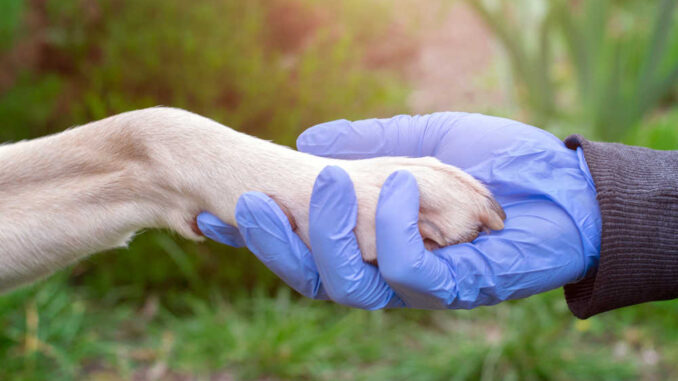
This article was updated on October 21st, 2023
When most people think of yeast, the first thing to come to mind would probably be a freshly baked loaf of bread, not their dog’s feet. But any owners who have experienced a dog with a paw yeast infection will tell you it’s not a pleasant sight, and certainly not a pleasant smell!
I’ll frequently see dogs with itchy, inflamed and irritated feet come through the clinic doors and it can be an ongoing battle for owners to try and stop their dogs from chewing at their feet. However, what many owners don’t know is that some of the causes of paw yeast infections in dogs can be easily remedied, often without a trip to the vet.
What yeast infections in dog paws look like [with pictures]
Paw yeast infections can take on a number of different appearances, often depending on the underlying cause. Some may be very mild and others severe. The typical symptoms of paw yeast infections in dogs include:
- Red inflamed skin – between the toes or on the top of your dog’s feet
- Itchy paws – your dog frantically licks or chews at their feet
- Hair loss – due to your dog chewing fur out
- Foul smell – yeast has a very strong unpleasant smell
- Wet discharge – severe infections may lead to very moist fur on your dog’s feet
- Saliva staining – discoloration to the fur above the feet due to your dog licking
Picture of a mild paw yeast infection:
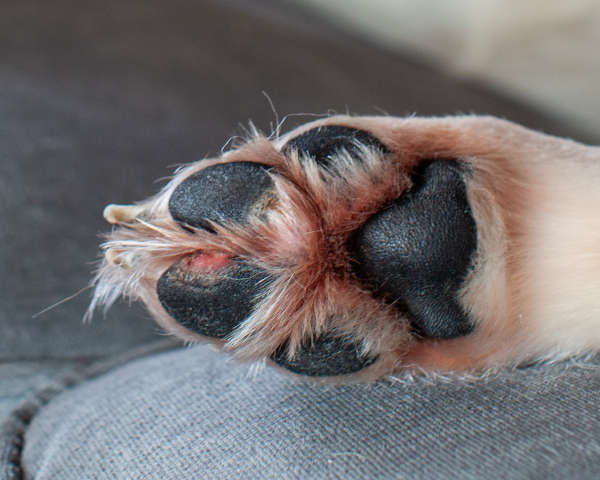
Picture of a moderate paw yeast infection:
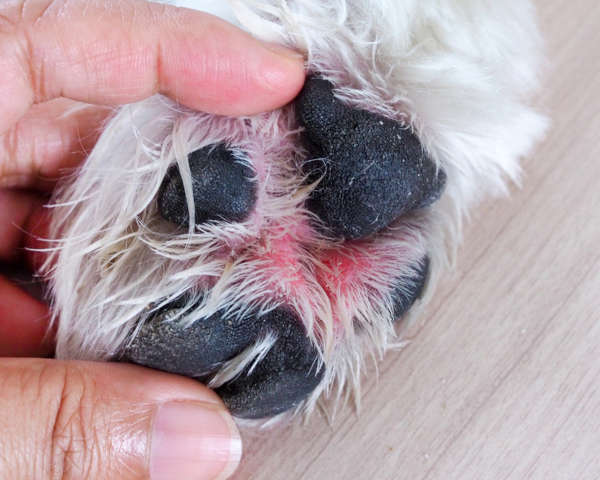
Picture of a severe paw yeast infection:
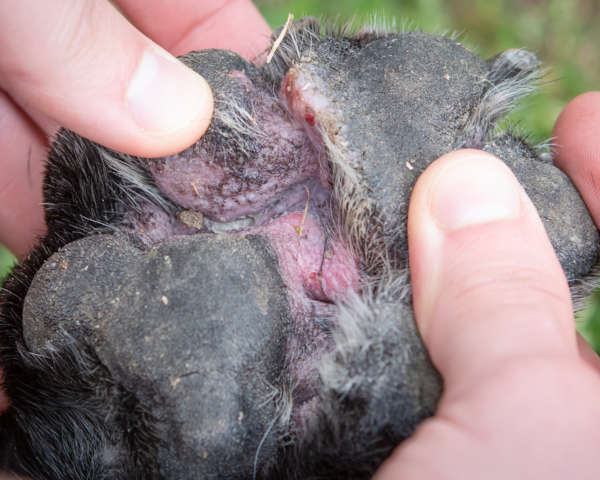
Home remedies to treat your dog’s paw yeast infections
Mild yeast infections may respond to some simple home remedy treatments. If your dog’s feet are just a bit smelly or a little damp and red then there are some products that owners could try at home first before seeking veterinary advice.
1. Clean your dog’s paws. Try soaking your dog’s paws in a medicated shampoo such as this one. Fill the bottom of a bathtub or container with warm water and mix in the shampoo to create a foamy solution. Allow your dog to stand in the water for 5-10 minutes, gently rubbing in between and the bottom of your dog’s feet to remove any large dirt particles.
2. Gently wipe your dog’s paws with medicated antifungal wipes such as this product. While this will likely only work for mild yeast infections, it can be a good way to clean your dog’s feet while on the move. Use the wipes to clean between all of the crevices and skin folds on your dog’s paws.
It’s important to be aware however that although these products are branded as medicated, the medication in them isn’t very high strength since you can purchase them without a prescription. It’s fine to try these products, but if they don’t make much of a difference then proper veterinary prescription medication may be required.
3. Consider your dog’s diet. Your dog’s diet is another important thing to take into consideration. As we have mentioned before, allergies can be a primary trigger for skin disease in dogs and might be the reason why your dog keeps getting repeated paw yeast infections. Try changing to a diet with a novel source of protein such as venison or buffalo. If that doesn’t work then I’d recommend a proper veterinary prescription hypoallergenic diet. Trial a diet for at least 4 weeks before making the decision as to whether it’s making a difference or not.
Recommended products for yeast infections
These are some great products that you can use to help treat and prevent yeast infections in your dog.
1. Antifungal Shampoo: This is one of my favorite shampoos for dogs with fungal infections. I use this shampoo on my own dog to help prevent yeast infections on her skin.
- MEDICATED SHAMPOO treats skin infections on cats and dogs
2. Antifungal Cream: This is a cream that you can use to help treat fungal infections topically:
- For the treatment of most athletes foot (tinea pedis), jock itch (tinea cruris), ringworm (tinea corporis)
3. Epson Salt: This is great to soak your dog’s feet to help dry up any infection. It is best to not use any epson salt with added scents such as eucalyptus.
- AT-HOME BATH & FOOT SPA: Add the nourishing effects of Epsom Salt to your daily bath with the Epsoak Epsom Salt (100% Pure Magnesium Sulfate), a USP-grade GMO-free expertly selected medium-grain bath salt to easily meet your body's magnesium needs
While many of these products are only good for mild infections, they can help with severe infections while waiting to see your vet for prescription medications. If you have used these products and have not seen any improvement after just a few days, it is best that your dog sees a vet.
Why do dogs get yeast infections?
Yeast is a normally harmless fungus that is found naturally in small amounts on your dog’s skin, it is known as a commensal organism as it usually lives on your dog’s skin without causing any problems. In fact, a healthy amount of yeast is essential as it helps fight off more harmful microorganisms and so plays an important part in your dog’s natural immune defenses.
Issues arise however when the amount of yeast growing on your dog’s skin becomes excessive or abnormal, non commensal forms of yeast start to grow. This overgrowth of yeast causes inflammation and irritation, leading to the symptoms listed above. The dark, warm, moist and often dirty environment of your dog’s paws is the ideal environment for yeast to thrive, not to mention the fact that your dog’s feet are always in contact with the ground where they could be picking up all kinds of dirt!
Most dogs with a strong immune system can keep yeast at bay and prevent it from multiplying to levels which could start to cause problems. A yeast infection often occurs due to some sort of underlying factor that either compromises your dog’s immune system or allows an overgrowth of yeast to occur.
Top causes of yeast infections in dog paws
There are many possible predisposing factors to a yeast infection; basically anything that breaks down the natural skin barrier between your dog’s toes and/or causes your dog’s paws to become more moist or warm than usual may be an underlying cause!
Here are the most common underlying causes of yeast infections in dog’s paws:
1. Allergies
Allergies are a leading cause of skin disease in dogs and the skin between your dog’s paws is no exception. If your dog eats something that they’re allergic to or comes into contact with something that triggers an allergic reaction, this can often result in inflammation of the skin in a similar way that a human may come out in hives or a rash. This can affect the skin anywhere on your dog’s body but the feet are a common offender!
Inflamed skin is no longer effective at maintaining the normal healthy barrier to microorganisms such as fungi and bacteria in the external environment. This allows the normal commensal yeast organisms found living on the surface of your dog’s skin to invade the tissues deeper within the skin, resulting in a yeast infection; the yeast cells multiply and damage the surrounding tissues in the process.
If you suspect your dog is suffering from allergies then visit your vet. Blood tests can be performed to identify underlying allergens. Your vet may also recommend a hypoallergenic diet to eliminate food allergens as a possible cause.
2. Dirty and moist skin
Foot hygiene is equally as important for our dogs as it is for us, in fact, perhaps even more so given all the gross places dogs like to put their paws! Repeated exposure to dirty, wet environments leads to a build up of muck on your dog’s paws and can cause the skin to crack and become damaged. This sets up the perfect environment for fungi like yeast to thrive and multiply, resulting in a nasty paw yeast infection.
Thankfully there’s an easy fix and it’s as simple as keeping your dog’s feet clean! Whenever you take your dog on a particularly dirty walk, it’s good to get in the habit of giving their feet a good wash afterward. This removes any dirt and microorganisms that might have become trapped between your canine companions’ toes. But be sure to thoroughly dry your dog’s feet afterwards as leaving them too wet can also create that warm moist environment that we know yeast loves so much.
3. Genetics
Unfortunately, some types of dog appear to be genetically predisposed to developing paw yeast infections. Breeds including West Highland White Terriers, Cockers Spaniels, Poodles, Basset Hounds and Bulldogs (to name a few) seem to be most at risk, but really any dog that has lots of tight skin folds and/or hairy feet is more likely to develop a yeast infection of the feet.
Although genetics are uncontrollable, all hope is not lost. With the good hygiene measures mentioned above and by ruling out any other underlying causes such as allergies, even the most predisposed dogs can live fungus-free.
How serious are yeast infections on dog paws?
The severity of a yeast infection will largely depend on how long it’s been left untreated as well as the underlying cause. Paw yeast infections are usually very uncomfortable for your dog; inflamed skin is painful and what’s more, the feet are constantly in contact with the ground which puts pressure on the area, causing more discomfort.
Some mild infections may be easy to get on top of if caught early – thoroughly cleaning your dog’s feet with the proper shampoo and anti-fungal cream may be all that’s needed. Other more severe infections may require long courses of antifungal treatment. What’s vital however, is that the underlying cause is addressed where possible. Is an allergy to blame? Or does your dog suffer from poor foot hygiene?
When to see the vet: signs that your dog’s paws can’t wait
If your dog’s paws are not getting any better despite the home remedies listed above, or if paw yeast infections are a recurring issue for your dog then they’ll need to see the vet. Similarly, if your dog is causing a lot of damage to himself by chewing his feet then this needs to be stopped before it gets worse.
How do vets diagnose paw infections?
Okay, so you’ve tried changing your dog’s diet and you’ve rigorously kept your dog’s paws as clean as you can, but the problem is just not going away. Now is the time to seek some help from your vet – but you may be wondering how your vet will diagnose a paw yeast infection.
A lot of the diagnosis can be done simply based on the appearance and smell of your dog’s feet; yeast has a very unique smell and there’s no mistaking it. To be absolutely certain that a fungal infection is present, your vet can take samples of any discharge present between your dogs toes. This can be examined under the microscope and the diagnosis of a yeast infection can be confirmed.
Veterinary treatment options for yeast infections
Luckily most yeast infections are treatable; a range of antifungal agents are available and most infections respond well to these. The challenge comes in identifying, treating and preventing the underlying cause.
Prescription medicated shampoos and ointments are usually the weapon of choice to get on top of a paw yeast infection. In more severe cases, a course of oral antifungal medication may be required.
In cases where underlying allergies are to blame then a course of anti-allergy treatment such as steroids might be required. This aims to reduce the inflammation to allow the skin barrier to heal and prevent your dog from self-traumatizing its feet by chewing.
How to prevent yeast infections from recurring in your dog’s paws
Preventing yeast infections from recurring involves identifying and minimizing the underlying cause be it allergies, poor hygiene or genetics.
If poor hygiene is to blame, your vet can give you some tips for keeping your dog’s paws clean. Getting into the habit of cleaning your dog’s feet after a walk is a good start. Antifungal shampoo footbathing once or twice a week is also a great way to prevent any yeast growth from getting out of control. Don’t do this too often however as a small amount of yeast on your dog’s paws is healthy and helps fight off more nasty infections!
If genetics are the culprit then a regular routine of foot cleaning will also help. A quick clean with antiseptic wipes each day can also keep your dog’s feet from getting too hot and sweaty.
As we’ve already mentioned, food allergies can be prevented by changing your dog’s diet onto a hypoallergenic food. Look for ‘hydrolysed protein’ on the packaging – this is an indicator of a truly hypoallergenic dog food. Where environmental allergens are to blame then your vet might want to start anti-allergy treatment.
Are there other types of infections or issues common in dog paws?
Yeast isn’t the only microorganism that can take up residence in your dog’s paws. Bacteria will invade the skin in a similar manner if the paws are too hot and moist or if the natural skin barrier is disrupted. Swollen paws and cracked pads are two other common issues affecting dog’s feet so be sure to check out our dedicated articles on those topics.
Related posts about paw issues:
 Dog Paw Allergy Issues: 6 Tips to Help Your Dog [With Pictures] - One of my pet parents brought her dog into the clinic because he was furiously licking and chewing on his… [...]
Dog Paw Allergy Issues: 6 Tips to Help Your Dog [With Pictures] - One of my pet parents brought her dog into the clinic because he was furiously licking and chewing on his… [...] White Bumps on a Dog’s Paw: Most Likely Reasons - If you’ve noticed a new white bump or lump on your dog’s paw you’re probably wondering what’s causing it. White… [...]
White Bumps on a Dog’s Paw: Most Likely Reasons - If you’ve noticed a new white bump or lump on your dog’s paw you’re probably wondering what’s causing it. White… [...]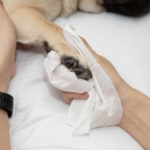 4 Cysts Often Found on Dog Paws [With Pictures & Vet Advice] - Ahh dog feet, giant Great Dane Marmaduke paws, tiny terrier tootsies, the puffy, fluffy white feet of a Bichon Frisé.… [...]
4 Cysts Often Found on Dog Paws [With Pictures & Vet Advice] - Ahh dog feet, giant Great Dane Marmaduke paws, tiny terrier tootsies, the puffy, fluffy white feet of a Bichon Frisé.… [...]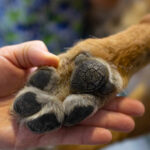 Paw Problems: 8 Common Lumps on Dog Paws [16 Pictures] - Seeing skin issues is a nearly everyday thing at our veterinary clinic. This article will help you identify lumps, bumps,… [...]
Paw Problems: 8 Common Lumps on Dog Paws [16 Pictures] - Seeing skin issues is a nearly everyday thing at our veterinary clinic. This article will help you identify lumps, bumps,… [...]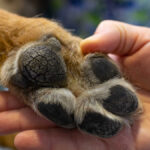 Dog with Cracked Paws? Our Veterinarian Explains What to Do - A dog’s feet often seem indestructible. After all, they’re on the go in all types of terrain, allowing your dog… [...]
Dog with Cracked Paws? Our Veterinarian Explains What to Do - A dog’s feet often seem indestructible. After all, they’re on the go in all types of terrain, allowing your dog… [...]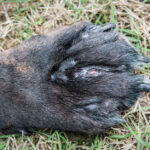 Dog with Swollen Paws [with Pictures] Our Veterinarian Explains What to Do - A dog with swollen paws or paw pads may be suffering from something as simple as a thorn in their… [...]
Dog with Swollen Paws [with Pictures] Our Veterinarian Explains What to Do - A dog with swollen paws or paw pads may be suffering from something as simple as a thorn in their… [...]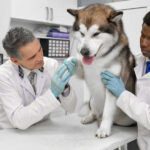 Dog Paw Infections and Issues: Pictures & Vet Advice - Dog paw infections are one of the more common issues that we treat in our veterinary hospital: dogs often excessively… [...]
Dog Paw Infections and Issues: Pictures & Vet Advice - Dog paw infections are one of the more common issues that we treat in our veterinary hospital: dogs often excessively… [...] Why Is My Dog Constantly Licking His Paws? Veterinarian Advice - You may notice your dog licking his paws on occasion. This is often just part of his everyday grooming routine;… [...]
Why Is My Dog Constantly Licking His Paws? Veterinarian Advice - You may notice your dog licking his paws on occasion. This is often just part of his everyday grooming routine;… [...]Disclaimer: This website's content is not a substitute for veterinary care. Always consult with your veterinarian for healthcare decisions. Read More.


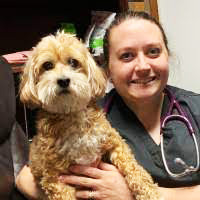


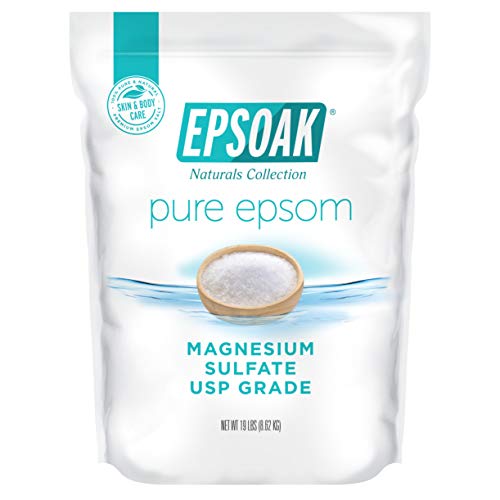

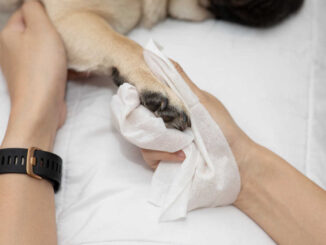
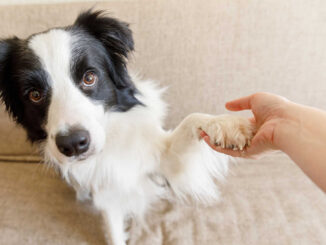
Be the first to comment